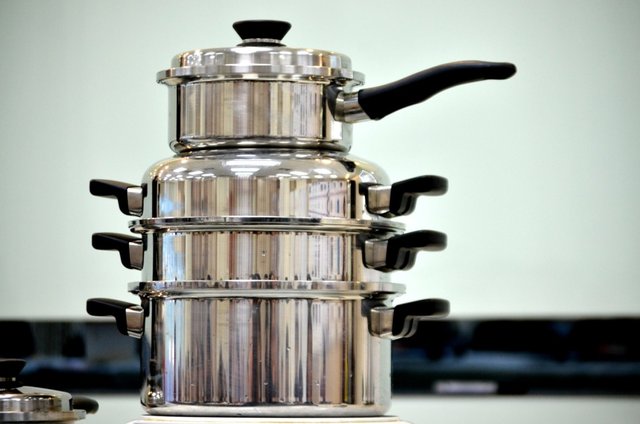
天气冷了每次做菜,前面做好了,到吃的时候就凉了。就想着买个蒸锅,在购物平台搜了下,发现不锈钢的蒸锅价格悬殊好大,就仔细观察了,有304不锈钢,有430不锈钢,有410不锈钢,还有些复合材料。于是就抱着学习的态度就一一百度了下。
首先304不锈钢是食品级的。
304不锈钢是不锈钢中常见的一种材质,密度为7.93 g/cm3,业内也叫做18/8不锈钢。耐高温800度,具有加工性能好,韧性高的特点,广泛使用于工业和家具装饰行业和食品医疗行业。
市场上常见的标示方法中有06Cr19Ni10,SUS304,其中06Cr19Ni10一般表示国标标准生产,一般表示ASTM标准生产,SUS 304表示日标标准生产。
304 是一种通用性的不锈钢,它广泛地用于制作要求良好综合性能(耐腐蚀和成型性)的设备和机件。为了保持不锈钢所固有的耐腐蚀性,钢必须含有18%以上的铬,8%以上的镍含量。304不锈钢是按照美国ASTM标准生产出来的不锈钢的一个牌号。
(资料来源于网络)
430不锈钢也称铁素体不锈钢:含铬12%~30%。其耐蚀性、韧性和可焊性随含铬量的增加而提高,耐氯化物应力腐蚀性能优于其他种类不锈钢。
属于这一类的有Crl7、Cr17Mo2Ti、Cr25,Cr25Mo3Ti、Cr28等。铁素体不锈钢因为含铬量高,耐腐蚀性能与抗氧化性能均比较好,但机械性能与工艺性能较差,多用于受力不大的耐酸结构及作抗氧化钢使用。这类钢能抵抗大气、硝酸及盐水溶液的腐蚀,并具有高温抗氧化性能好、热膨胀系数小等特点,用于硝酸及食品工厂设备,也可制作在高温下工作的零件,如燃气轮机零件等。
(资料来源于网路)
410不锈钢属于马氏体不锈钢:强度高,但塑性和可焊性较差。
马氏体不锈钢的常用牌号有1Cr13、3Cr13等,因含碳较高,故具有较高的强度、硬度和耐磨性,但耐蚀性稍差,用于力学性能要求较高、耐蚀性能要求一般的一些零件上,如弹簧、汽轮机叶片、水压机阀等。这类钢是在淬火、回火处理后使用的。
(资料来源于网络)
今天也算是给自己上了一课了,买东西时还是得看清商品属性,价格悬殊的同类商品肯定有不一样的地方。
注:涉及名词解释均来源于网络。
The weather is cold every time I cook, the front is done, and it is cold when I eat. Just thinking about buying a steamer, searched on the shopping platform, found that the stainless steel steamer price is very different, it was carefully observed, there are 304 stainless steel, 430 stainless steel, 410 stainless steel, and some composite materials. So I took the attitude of learning and Baidu.
First of all, 304 stainless steel is food grade.
304 stainless steel is a common material in stainless steel with a density of 7.93 g/cm3, also known as 18/8 stainless steel. With high temperature resistance of 800 degrees, it has the characteristics of good processing performance and high toughness. It is widely used in industrial and furniture decoration industry and food medical industry.
Among the common marking methods on the market are 06Cr19Ni10 and SUS304, of which 06Cr19Ni10 generally represents the national standard production, generally indicates ASTM standard production, and SUS 304 indicates Japanese standard production.
304 is a versatile stainless steel that is widely used to make equipment and parts that require good overall performance (corrosion resistance and formability). In order to maintain the corrosion resistance inherent in stainless steel, the steel must contain more than 18% chromium and more than 8% nickel. 304 stainless steel is a grade of stainless steel produced in accordance with American ASTM standards.
(data from the network)
430 stainless steel is also called ferritic stainless steel: containing 12% to 30% chromium. Its corrosion resistance, toughness and weldability increase with the increase of chromium content, and its resistance to chloride stress corrosion is better than other types of stainless steel.
Among these, there are Crl7, Cr17Mo2Ti, Cr25, Cr25Mo3Ti, Cr28 and the like. Ferritic stainless steel has high corrosion resistance and oxidation resistance because of its high chromium content, but its mechanical properties and process performance are poor. It is mostly used for acid-resistant structures with little stress and used as anti-oxidation steel. This kind of steel can resist the corrosion of atmospheric, nitric acid and saline solution, and has the characteristics of high temperature oxidation resistance and small thermal expansion coefficient. It can be used in nitric acid and food factory equipment, and can also manufacture parts working at high temperature, such as gas turbine parts. .
(data from the Internet)
410 stainless steel is a martensitic stainless steel: high strength, but poor plasticity and weldability.
The commonly used grades of martensitic stainless steels are 1Cr13, 3Cr13, etc., because of the high carbon content, they have high strength, hardness and wear resistance, but the corrosion resistance is slightly poor, which is used for high mechanical properties and corrosion resistance. General parts are required, such as springs, steam turbine blades, hydraulic press valves, etc. This type of steel is used after quenching and tempering.
(data from the network)
Today is also a lesson for myself. When you buy something, you still have to see the attributes of the goods. There must be different places for similar products with different prices.
Note: The terminology involved is derived from the network.